It’s a mouthful. x Chiranthomontodendron lenzii, the hybrid monkey hand tree, is the result of an intergeneric cross between the Mexican monkey hand tree, Chiranthodendron pentadactylon, native to Guatemala and adjacent parts of Mexico, and the flannelbush cultivar Fremontodendron ‘Pacific Sunset’. The latter is itself a cross between F. californicum, native primarily to California, and F. mexicanum, native to northern Baja California and adjacent parts of San Diego County.
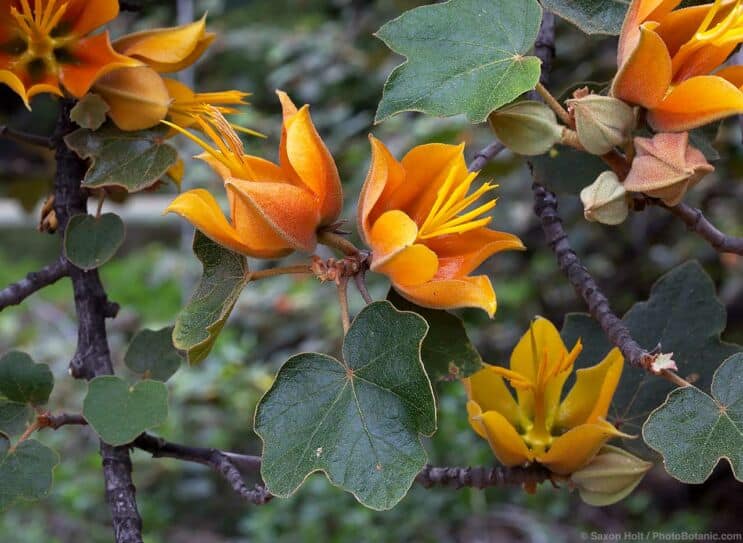
Distinctive flowers and leaves of x Chiranthomontodendron lenzii, hybrid monkey hand tree
As are its parents, the hybrid monkey hand tree is best known for its distinctive flowers, which display characteristics of both parents or intermediate between the two. Flowers of all three have five sepals that look like petals and a unique arrangement of five stamens joined at the base and spread like the fingers of a raised hand. Leaves usually are palmate with five lobes resembling those of genus Acer (maple), glossy green and somewhat leathery above, hairy and tawny beige below.
But what’s the story behind that awkward name? The simple answer is that the International Code of Botanical Nomenclature requires that hybrids involving two genera be given a name that combines portions of the names of both parents. That, of course, is not the whole story. . .
The cross was successfully made in the early 1980s, after repeated attempts, by plantsman Austin Griffiths. At the time Griffiths was a student at Claremont Graduate University, a cooperative venture between Rancho Santa Ana Botanic Garden (now California Botanic Garden) and Pomona College.
Informally and without scientific documentation, Griffiths named the newly made hybrid Leelenzia ranchorum, the genus name honoring Lee W. Lenz, director of the botanic garden from 1960 to 1983.
Known primarily for his work with Iris and Yucca, Lenz devoted much of his time to breeding and hybridizing California native plants for introduction to horticulture. It can be assumed that his work was the primary impetus behind Griffiths’ persistent efforts to produce the challenging monkey hand/flannelbush cross.
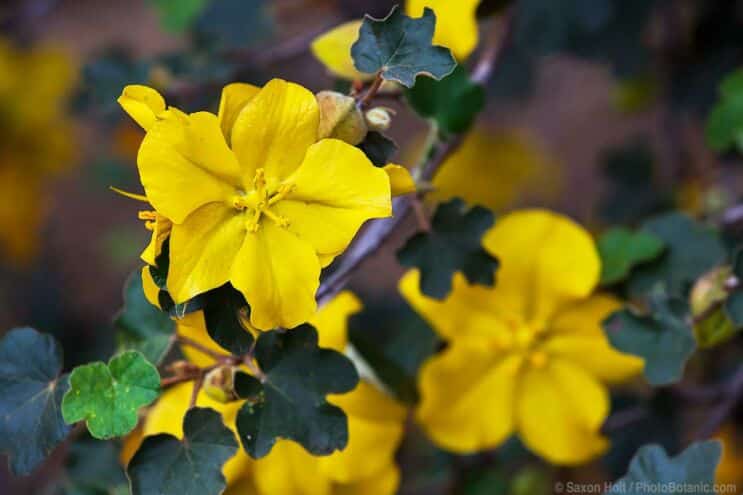
Fremontodendron ‘Pacific Sunset’, a hybrid between F. californicum and F. mexicanum
From its inception in the late 1920s and early ‘30s, Rancho Santa Ana Botanic Garden (RSABG) has been focused on the conservation of native plants, with emphasis on research and development. The Garden has bred, named, and introduced many now widely grown selections and hybrids to the horticultural trade.
The monkey hand hybrid was propagated and introduced to the trade by RSABG as x Chiranthofremontia lenzii. It was formally described and named in 1991 by James Henrickson, a California State University professor who received his PhD at the Clarement Graduate University in 1969.
That name persisted until 2009, when Laurence Dorr, research botanist and curator of botany at the Smithsonian’s National Museum of Natural History, updated and published the name of the hybrid as x Chiranthomontodendron lenzii. This name change was required by an earlier name change for one of its parents: the genus Fremontodendron.
The genus Fremontodendron was initially named Fremontia in 1853 by John Torrey, American botanist, physician, and author of many publications on the flora of the United States. One of these was an 1851 report on plants collected by the controversial botanist/explorer John C. Fremont, who led several expeditions in the early 1840s to map and document routes to the American west.
In that 1851 report Torrey applied the name Fremontia vermicularis to a common shrub of arid regions, only later discovering that the same plant had been described and named in 1839 by German botanist Christian Nees von Esenbeck.
The 1853 name Fremontia thus was considered an invalid homonym (same name for a different plant) and an accepted synonym (different name for the same plant) of the genus Sarcobatus, which today includes the species commonly known as greasewood (S. vermiculatus and S. baileyi).
This problem was resolved in 1893 when Frederick Coville, chief botanist at the U.S. Department of Agriculture and first director of the U.S. National Arboretum, created a new genus, Fremontodendron, and placed the California flannelbush within it. The scientific name for this plant today is Fremontodendron californicum (Torr.) Coville.
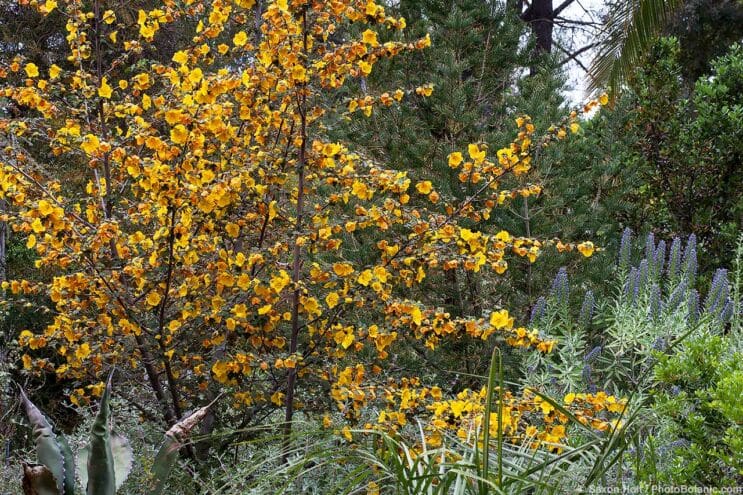
Fremontodendron ‘California Glory’, another hybrid between F. californicum and F. mexicanum
There were multiple subsequent attempts to retain (“conserve”) the 1853 name Fremontia for the California flannelbush collected by John Fremont, but the Nomenclature Committee of the International Association of Plant Taxonomists ruled against this in 1954.
The name Fremontia nonetheless was used by Philip Munz, botanist and director of the RSABG from 1946 to 1960, in his highly regarded Flora of California (1959, 1968). This undoubtedly contributed to its continued use by the horticulture industry and by many scientists.
The name fremontia is still in use as a common name for flannelbush (as is leelenzia for the monkey hand hybrid) and is retained in the nursery trade in the still popular name of the hybrid monkey hand tree Chiranthofremontia lenzii.
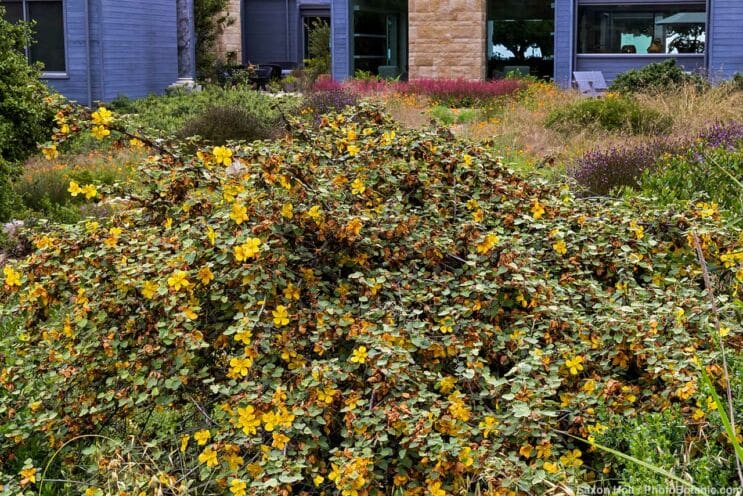
Fremontodendron ‘Ken Taylor’ is a dwarf hybrid of F. californicum subsp. decumbens and F. ‘California Glory’
The genus name Chiranthodendron has also undergone changes over the years, although the impacts on horticulture have been less far-reaching. The Mexican monkey hand tree was first described by that name in a 1795 article by Joseph D. Larreategui, a botanist/physician at the Royal Botanical Garden of Mexico.
In 1803 Antonio Cavanilles, director of the Royal Botanical Garden of Madrid, republished portions of Larreategui’s article in Spain, changing the genus name Chiranthodendron to Chirostemon, apparently at the request of Vicente Cervantes, director of the Mexican Royal Botanical Garden. In subsequent publications, republications, and translations in Spanish, French, and German, the plant was variously described as Cheirostemon platanoides (1806), Cheirostemon apetalus (1806), and Chiranthodendron platanoides (1872).
Today, as James Henrickson pointed out in his 1991 description and naming of x Chiranthofremontia lenzii, the 1795 name Chiranthodendron pentadactylon Larreat. clearly has priority. C. platanoides, Cheirostemon platanoides, and Cheirostemon apetalus are considered by some to be synonyms.
Chiranthomontodendron lenzii Dorr. (2009) is accepted, although not universally used, as the correct name for the hybrid monkey hand tree.
What can be learned from this story is that changes in plant names are often debated or challenged by other scientists and they can be disconcerting for the rest of us, but they are rarely arbitrary.
For those wishing to grow the hybrid monkey hand tree or either of its parents, it should be noted that while flannelbush is consistently offered in the trade as Fremontodendron and the Mexican monkey hand tree is usually offered as Chiranthodendron, the hybrid is still popularly known as x Chiranthofremontia lenzii, especially in the nursery trade.
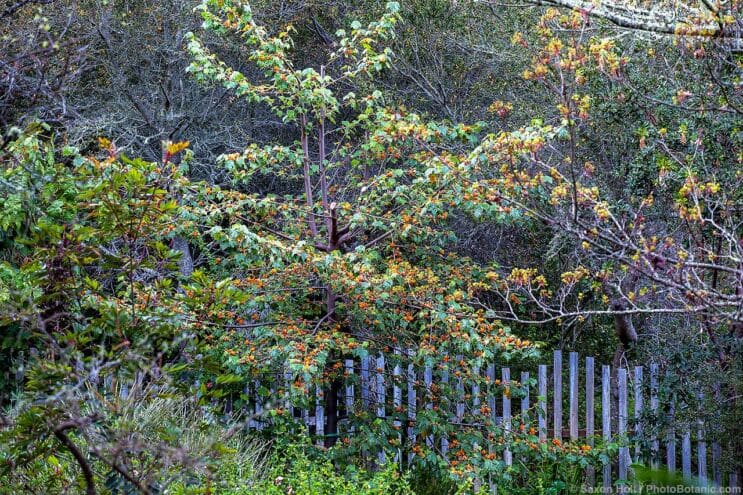
In cultivation x Chiranthomontodendron lenzii can become a mid-sized tree.
The hybrid and its parents differ in several ways. Chiranthodendron is a large tree, to 50 feet tall or more in cultivation and almost twice that in the wet montane forests of Guatemala. Fremontodendron, in most of its forms and varieties, is a large shrub, 12-20 feet tall, in cultivation as in the dry chaparral and coniferous woodlands in which it naturally grows. The hybrid can become a large shrub/tree to 30 feet tall and 20 feet wide.
Perhaps most important for gardeners, all three plants need sun, fairly mild winters, and good drainage. The Mexican plant grows naturally on wet but fast-draining slopes while the California native prefers a dry summer along with near-perfect drainage.
I haven’t grown the Mexican monkey hand tree or the hybrid, but I know from painful experience that Fremontodendron ‘California Glory’ can be quickly done in by almost any amount of direct summer irrigation, even at the top of a sunny, well-drained slope in summer-dry northern California.
If you grow or have grown any of these plants feel free to let us know. We all gain from the shared experiences of others.


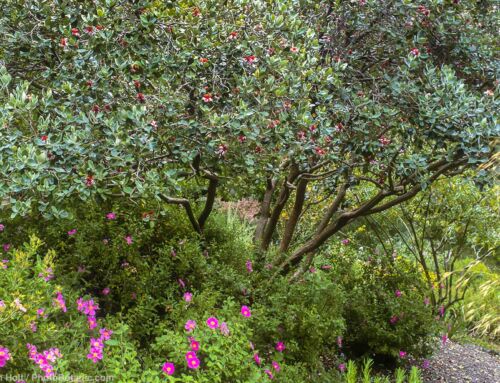
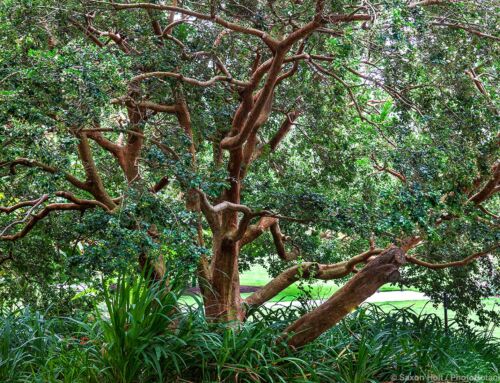
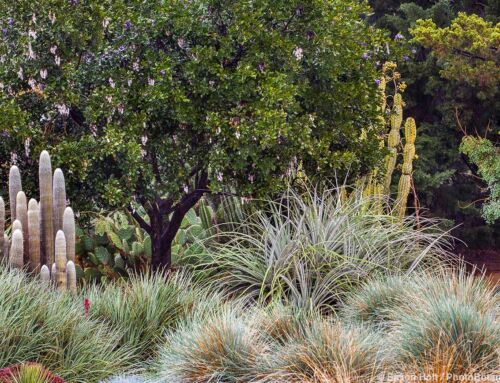
Hi Saxon: We have two such specimens ( Chiranthomontodendron lenzii ) growing in our Tiburon garden….One planted 6 yrs. ago is now 20-25’tall and the other was planted 2 yrs. ago is 12′ tall …both are just now coming into bloom. They ware purchased at SFBG plant sales. They provide bright yellow color in the garden and the birds love the flower nectar. Hope all is well with you.
Best regards, Roger and Mary Greenberg
Thanks for your comment Roger. Good to hear your first-hand experience with the hybrid. That is certainly fast growth.
Nora
Hi Saxon and Nora,
I worked at California Botanic Garden, the former RSABG, for almost 9 years and am well aquatinted with Chiranthomondodendron. While they didn’t get watered often, they will tolerate summer water better than Fremontodendron. I used to drive Lee Lenz around the garden in a cart, on occasion, in his last years. One day while tooling him around, he told me to stop as we drove by them, and chastised me for not giving them enough water. After that we did water them more frequently, even in the summer, with no death of the plants. They do become huge and are not for the average residential garden. Visitors to the garden were enthralled with them when they were in bloom and would always ask what they were.
Keep up your good work – Peter Evans
Keep up your good work – Peter Evans
Thank you, Peter, for your comments and your insights about watering. I haven’t grown the hybrid and didn’t know it would accept summer watering. Good to hear from someone who worked at the garden and knew Lee Lenz.
Nora